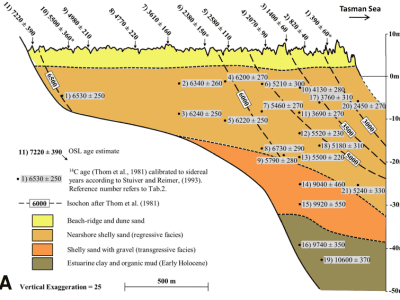Coastal morphostratigraphy: two papers from Denmark

An Australian example of barrier morphostratigraphy – Moruya (Source: Oliver et al 2014)
Many years ago I was introduced to the concept of morphostratigraphy in reading the work of John Frye from Kansas Geological Survey. He used the term in his study of glacial geology/geomorphology in the US mid-west. My PhD work on Cainozoic coastal sequences in South Carolina invoked the concept as did Bob Mixon from the US Geological Survey in North Carolina (both in the late 1960s). By using a combination of landform mapping, drilling and where possible dating, we were able to construct conceptual models of depositional history involving an appreciation of facies and morphological types. A similar approach was used in eastern Australia by Peter Roy and me in different places starting in the 1970s. These morphostratigraphic studies have assisted the development of sophisticated morphodynamic modelling on the origins of Holocene strandplains by Cowell, Kinsela and Daley (e.g. Kinsela, M., et al., 2016, Marine Geology).
Recently, Tom Oliver kindly drew my attention to two papers involving the evolution of coastal sand barriers on the North Sea coast in Denmark. Two neighbouring locations were studied: Skallingen-Lanngli and Fano. From my perspective they constitute morphostratigraphic research par excellence. Over the years I have greatly admired the work on Holocene barriers/strandplains that have involved multiple techniques including drilling and dating. Early work on the US Gulf Coast by Fisk and Bernard amongst others, on the US east coast by Kraft, in Mexico by Curray, and especially the early work in Holland by van Straaten, have been inspiring. But recent papers by Mikkel Fruergaard and co-authors in Denmark highlight just what can be done when an array of tools are brought into play to provide a high-resolution reconstruction of barrier landforms and depositional sequences. One paper is in Sedimentology (2015, 62, 928-969), the other in the Journal of Sedimentary Petrology (2015, 85, 820-844).
What really excites me about these two studies is the degree of detail in documenting the depositional record beneath transgressive-regressive barrier systems. One can get very envious in seeing just what can be done when able to apply various new methods to a morphostratigraphic sequence. They used DEM to assist with topographic mapping; GPR to penetrate aeolian surface sediments into underlying marine deposits; percussion coring enabling facies determination of well-preserved cores; and from these cores many OSL dates (53 in one paper and 92 in another; supplemented by radiocarbon dates). Given we were limited to radiocarbon in years gone by, as were the others mentioned above, what Fruergaard and colleagues have done is simply staggering. They beautifully illustrate their cores and sections to provide evidence for their interpretation of the Holocene evolution of this section of the North Sea coast.
In essence, they give a detailed reconstruction of the sedimentological and morphological effects of sea-level rise on a Holocene barrier system. Barriers grew and changed their form while sea level continued to rise albeit at a declining rate to the present. Unlike eastern Australia, but similar to locations like those mentioned above in the classic barrier papers, there has been no stillstand or fall in relative sea level along this North Sea coast. They documented multiple phases of transgression and regression during the mid to late Holocene and argued that these changes were driven primarily by a combination of changes in the rates of sea-level rise, sediment supply, and the impact of storms. At first rapid relative sea-level rise outpaced sediment accumulation before it slowed to rates of 4 mm/yr. or less allowing for backbarrier sediment accumulation before such facies and landforms were transgressed by a retreating open ocean shoreline. However, over the last 2500 years, barrier sedimentation has kept up and “outpaced sea level”. In the two studies they showed that sediment accumulation could be quite variable with episodic progradation depending on sediment supply. They note that progradation occurred despite a sea-level rise of about 1.7 to 1.8mm/yr.
Their morphostratigraphic research is quite insightful given the degree to which they have documented shoreline evolution under conditions of a continuously rising sea level. Pointedly they say that barrier evolution is not only controlled by rates of sea-level rise; by implication it is too simplistic to attribute shoreline change to that factor without also taking into consideration storm regime and regional coastal morphology which affects sediment supply. They conclude by saying their two studies highlight “the challenge in making general inferences about barrier-island response to sea-level rise”.
While they showed rates in excess of 4mm/yr. indicated “marine flooding”/transgression along this section of the sediment-rich Danish coast, how relevant is that rate to other sandy shores now undergoing sea-level rise? Our study of 350 sediment compartments around the Australian coast (Thom et al., 2018, Ocean and Coastal Management, 154, 103-120) highlighted the need to understand sediment dynamics in any consideration of future shoreline behaviour.
What Fruergaard and colleagues have demonstrated is that by undertaking a detailed, high-resolution reconstruction of mid to late Holocene coastal evolution, it is possible to be more specific about the way future changes in wave climate, sea level and sediment supply will influence coastal behaviour in different sediment compartments.
Bruce Thom
Words by Prof Bruce Thom. Please respect the author’s thoughts and reference appropriately: (c) ACS, 2019, for correspondence about this blog post please email austcoastsoc@gmail.com
#149


 Climate Change Attribution
Climate Change Attribution